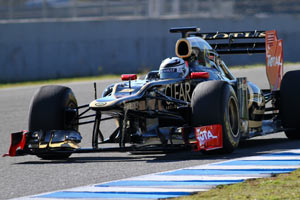James Allen wrote:Veteran technical journalist Giorgio Piola is writing that Lotus Renault GP has a system which brings back echoes of the “mass-damper”, one of the innovations when the team was known as Renault, that helped to win it the 2006/6 world championships.
According to Piola, the system is mechanical, operated by the driver (like the F Duct) and means that when the driver hits the brakes, it manages the ride height as the front of the car dives down, which in turn helps to keep the front wing’s performance more consistent.
The system enables the team to run a lower front ride height, as the thing which dictates how low the ride height can be on an F1 car is the limit of downward movement at the moment of peak braking.
Red Bull, Ferrari and others experimented in the last couple of years with ‘flexi-wings’, but this system will allow the front ride height to be low in a simple and efficient way.
It also has a great benefit in the races, as the cars start with 150kg of fuel, which drops to zero over the course of the race. Keeping the ride height optimised, as the car rises with a reduction on fuel load, gives a gain in lap time. We saw Ferrari lowering the ride height legally in pit stops as the fuel burns off, but this system would again have a benefit there. A tenth or two of a second per lap adds up over a 70 lap race.
The system is linked to a hydraulic cylinder inside the brake cowling. The suspension and uprights are connected to a tiny hydraulic cylinder in the upright, which can provide a few millimetres of lift at the crucial moment of the braking phase, activated by the driver.
One of the few technical rule changes for this year is the lowering of the nose of the car from a maximum of 62cm to 55cm, which when taken with the ban on off throttle blown diffusers puts an emphasis on front wing performance and means that braking stability will be affected.
As some 16% of the lap at many venues is spent braking, there are some useful gains to be made there if you can keep the car optimised when the nose dives under braking.
The system can be used in reverse under acceleration, to reduce the amount of lift in the nose and keep the front wing aerodynamics optimised.
The eagle eyed Piola, who started in F1 back in the late 1960s, spotted the cylinder in photos from the Abu Dhabi young driver test and has analysed it. Since that test the front wing regulations were finalised, but Lotus, led by technical director James Allison, was obviously ahead of the game. They are an innovative crowd, without the resources of a McLaren or a Red Bull, but with plenty of bright ideas. Last year they tried to innovate with the front blowing exhausts, which didn’t work.
http://www.jamesallenonf1.com/2012/01/h ... ave-gizmo/







